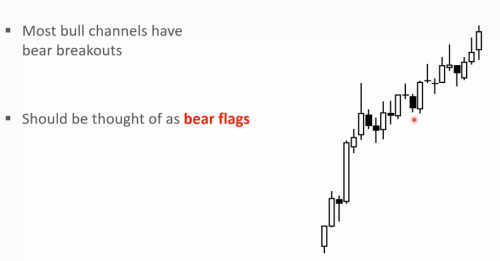The support forum is built with (1) General and FAQ forums for common trading queries received from aspiring and experienced traders, and (2) forums for course video topics. How to Trade Price Action and How to Trade Forex Price Action videos are consolidated into common forums.
Brooks Trading Course social media communities
Al Brooks mentions that a bull channel should always be seen as a bear flag and a bear channel should always be seen as a bull flag. I get the general idea so it is not something that confuses me about the statement.
However, it does bewilder me a little.. Al states many times that we should not trade against the trend. But if we are trying to find a place to go short in a bull channel, which is a breakout and a bull trend, then that is exactly what we are doing, isn't it? To me it seems very counterintuitive.
Maybe I am seeing this in the wrong way?
Hope you can help(?) 🙂
Video 16E - Slide 7.
This concept troubled me too when I was learning it. It takes some time to get used to some of the concepts in the course and as you progress through it, things get easier.
Coming to your question, as you know the market is in one of the 4 phases - breakout, channel, broad channel and trading range. So, the thing is, however strong a trend is, it does not last forever. It weakens over time and passes through the above phases(it might skip a phase sometimes).
So, when a market is in a channel, it is a pretty strong trend and a breakout on a higher timeframe. However, there is a 75% chance roughly of a bear breakout to a bull channel and a bull breakout to a bear channel. There is also a probability of 75% that such breakouts will fail within 5 bars(on the highest time-frame chart on which such channel is visible). So, what happens is, the trend weakens with the breakout of such channels but it does not necessarily mean that the trend has reversed altogether. It simply means that the market is moving from the channel phase to the broad channel phase or a trading range.
Hopefully, that clarifies your doubt a little and doesn't create more doubts 😛 .
Good answer. I get it. Thank you. 🙂
Hi guys. I still have issues with this bull trend bear flag..Working on context and defining what is difference on a pullback and a reversal. Did get some understanding from the small pullback bull trend and that bears can only scalp in a strong bull trend, and bulls can only scalp in a strong bear trend. Al does make a point that it is mostly futile to short a SM bull pullback trend, says its better to wait than go counter-trend. Higher time frames do help in defining context and the over-all main trend. Cheers
Major reversals normally break the trend line and test back in the original direction (conversion to a trading range first). Minor reversals (pullbacks) are normally brief. However, sometimes the minor reversal can become major.
It’s reasonable to take minor reversal setups (strong trend but may have a wedge combined with final flag or measured move etc) because you can sometimes get 2X risk out of it and there is a slight chance it becomes major. But normally it’s better to wait for the trading range transition if going for major reversal.
This is my take on it from a swing trading perspective. There are more experienced traders than me that may have a different answer to your question.
To me, its okay to take countertrend trades in a channel. The low risk may more than offset the low probability. But why bother? Who would enjoy a swing win loss ratio of less than 1:3 when there are so many better trades (scalp or swing) to take.
Respectfully, why "look" for reversals - because you are risk-averse?
Thanks for the reminder on trend-line breaks and trading range set-ups. There have been many 2nd entry set-ups lately too. Thanks

